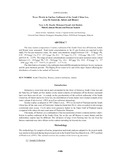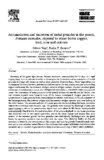| dc.contributor.author | Cuvin-Aralar, Maria Lourdes A. | |
| dc.contributor.author | Aralar, Emiliano V. | |
| dc.date.accessioned | 2013-02-25T08:17:33Z | |
| dc.date.available | 2013-02-25T08:17:33Z | |
| dc.date.issued | 1995 | |
| dc.identifier.citation | Cuvin-Aralar, M. L. A., & Aralar, E. V. (1995). Resistance to a heavy metal mixture in Oreochromis niloticus progenies from parents chronically exposed to the same metals. Chemosphere, 30(5), 953-963. | en |
| dc.identifier.issn | 0045-6535 | |
| dc.identifier.uri | http://hdl.handle.net/10862/1476 | |
| dc.description | Poster presented at the Fifth International Symposium on Genetics in Aquaculture, June 19–25, 1994, Halifax, Nova Scotia, Canada. | en |
| dc.description.abstract | Adult Oreochromis niloticus were mass spawned in concrete tanks. The one-month old progenies (F1) were exposed for two months to a mixture of 0.01 mg L−1 Hg, 0.1 mg L−1 Cd and 1.0 mg L−1 Zn. The survivors were grown to sexual maturity in a natural environment (lake). The fish were spawned and the progenies (F2) of the exposed F1 (EF1) were exposed to another mixture of the three metals: 3.0 mg L−1 Zn, 0.30 mg L−1 Cd and 0.01 mg L−1 Hg, both in a static and static-renewal system. Another group of F2 from unexposed F1 (UF1) received the same treatment. Results showed that in both exposure systems, survival of the F2 of EF1 was significantly higher (P<0.05) than those from UF1. The medial lethal time (LT50) of the F2's were estimated from the time-response curve following regression analysis: 5.16 days (F2 of UF1) and 9.03 days (F2 of EF1) in the static exposure experiment; 3.34 days (F2 of UF1) and 5.52 days (F2 of EF1) in the static-renewal run. Exposure of the parental stock resulted in the culling out of individuals which were more susceptible to the heavy metals. The more resistant members of the population (survivors) which have the ability to adapt to the toxicants were able to pass on the resistance to their offspring. The results are supported by other studies in the field which demonstrate high resistance in populations of organisms living in contaminated sites. | en |
| dc.language.iso | en | en |
| dc.publisher | Elsevier | en |
| dc.subject | Oreochromis niloticus | en |
| dc.subject | Pisces | en |
| dc.subject | chronic toxicity | en |
| dc.subject | genotoxicity | en |
| dc.subject | heritability | en |
| dc.title | Resistance to a heavy metal mixture in Oreochromis niloticus progenies from parents chronically exposed to the same metals | en |
| dc.type | Article | en |
| dc.citation.volume | 30 | |
| dc.citation.issue | 5 | |
| dc.citation.spage | 953 | |
| dc.citation.epage | 963 | |
| dc.citation.journalTitle | Chemosphere | en |
| dc.subject.asfa | adaptation | en |
| dc.subject.asfa | aquatic environment | en |
| dc.subject.asfa | biological resistance | en |
| dc.subject.asfa | cadmium | en |
| dc.subject.asfa | fish | en |
| dc.subject.asfa | heavy metals | en |
| dc.subject.asfa | lakes | en |
| dc.subject.asfa | mercury | en |
| dc.subject.asfa | natural selection | en |
| dc.subject.asfa | pollution tolerance | en |
| dc.subject.asfa | toxicity tests | en |
| dc.subject.asfa | zinc | en |
| dc.identifier.doi | 10.1016/0045-6535(94)00001-B | |



